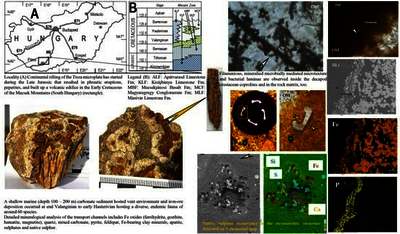Bujtor, László and Gyollai, Ildikó and Szabó, Máté Zoltán and Kovács, Ivett and Polgári, Márta Piroska (2024) Bacteria-Driven Fossil Ecosystems as Paleoindicators of Active Continental Margins and the Role of Carbonate Sediment-Hosted Vents in Geodynamic Reconstructions. MINERALS, 14 (2). No.-125. ISSN 2075-163X
|
Text
BujtorLetal_Mineral_2024.pdf - Published Version Available under License Creative Commons Attribution. Download (10MB) | Preview |
|
![[img]](https://real.mtak.hu/222635/7.hassmallThumbnailVersion/minerals-14-00125-ag-550.jpg)
|
Text (graphical abstract)
minerals-14-00125-ag-550.jpg - Published Version Available under License Creative Commons Attribution. Download (53kB) | Preview |
Abstract
Continental rifting of the Tisza microplate started during the Late Jurassic and resulted in phreatic eruptions, peperite, and the construction of a volcanic edifice in the Early Cretaceous in the Mecsek Mountains (South Hungary). In the SE direction from the volcanic edifice at Zengővárkony, a shallow marine (depth 100–200 m) carbonate sediment hosted a vent environment, and iron ore deposition occurred at the end of the Valanginian to early Hauterivian, hosting a diverse, endemic fauna of approximately 60 species. The detailed mineralogical analysis of the transport conduits included Fe oxides (ferrihydrite, goethite, hematite, and magnetite), quartz, mixed carbonate, pyrite, feldspar, Fe-bearing clay minerals, apatite, sulfates (barite, gypsum, and jarosite), and native sulfur. Filamentous, microbially mediated microtextures with inner sequented, necklace-like spheric forms (diameter of 1 μm) and bacterial laminae are also observed inside decapod crustacean coprolites (Palaxius tetraochetarius) and in the rock matrix. This complex ecological and mineralogical analysis provided direct evidence for the presence of bacteria in fossil sediment-hosted vent (SHV) environments on the one hand and for the intimate connection between bacteria and decapod crustaceans in hydrothermal environments 135 Ma before. This observation completes the fossil food chain of chemosynthesis-based ecosystems, from primary producers to the top carnivores reported for the first time from this locality.
| Item Type: | Article |
|---|---|
| Additional Information: | Institute of Geography and Environmental Sciences, Eszterházy Károly Catholic University, 6-8 Leányka Street, Eger, H-3300, Hungary HUN-REN Research Centre for Astronomy and Earth Sciences, Institute for Geological and Geochemical Research, Budaörsi út 45, Budapest, H-1112, Hungary HUN-REN Research Centre for Astronomy and Earth Sciences, MTA Centre of Excellence, Konkoly Thege Miklós út 15-17, Budapest, H-1121, Hungary Export Date: 25 March 2024 Correspondence Address: Polgári, M.; Institute of Geography and Environmental Sciences, 6-8 Leányka Street, Hungary; email: rodokrozit@gmail.com |
| Uncontrolled Keywords: | chemosymbiotic fossil ecosystem; food chain; low-temperature venting; Valanginian– Hauterivian; Tisza microplate; bacteria–decapod dependence; mineralogy |
| Subjects: | Q Science / természettudomány > QE Geology / földtudományok |
| SWORD Depositor: | MTMT SWORD |
| Depositing User: | MTMT SWORD |
| Date Deposited: | 23 Aug 2025 16:11 |
| Last Modified: | 23 Aug 2025 16:11 |
| URI: | https://real.mtak.hu/id/eprint/222635 |
Actions (login required)
 |
Edit Item |




